
Mini House (2008)
Prefabricated house concept
The concept
The idea behind Mini House started in 2007 as a simple, but refined 15 square meters cabin equipped as a weekend resort or guest house. Flat-pack delivery and quick set-up was key features. The project focused on three areas of developement; building code optimization, creating a defined Product and optimizing production. The first criteria was to challenge the Swedish building code by pushing the limits for what was allowed within the permit-free regulations. Among other things, Mini House took advantage of the regulations for “non-compact structures” to create the outdoor pergola which enhances the experience of volume and space. Furthermore, as a second priority the concept addressed marketing and communication values, by suggesting a better defined “product” than what was currently on the market. Jonas Wagell looked at the automotive industry and questioned why a house would have a lower level of identification and packaging.
In 2014, the concept was simplified and adopted to availability outside of Sweden. It now includes prefabricated volumes to be transported on a truck and placed on the final site with a mobile crane. All houses have interior finishing with wood floors, wood panel interior walls and a few selected optional interior solutions like bathroom, kitchen, bedroom and storage installed from the factory. In theory, only a plinth foundation needs to be prepared, unless the houses are equipped with kitchen or bathroom, which will require further planning and work (and local permits) in regards to sewage, water, electricity etc.
The main difference with the new models – Mini House 2.0 – is that they are completely prefabricated. Dimensions are optimized for shipping pre-build and some structural changes have been made to accommodate this. Moreover, the factory prebuilt models enable all interiors to be finalized indoors, and the houses are basically ready for use once they are unloaded and adjusted in place on the final destination.
Two fifteen square meter versions are the standard models, but the houses could also be manufactured in extended lengths on request and connected by the short-sides. Another alternative is to join two individual volumes with an outdoor pergola roof and wood deck – straight, or in customized angles.
The standard models are developed in two versions; Long and Wide. Both can be combined into houses up to 30 to 45 square meters, and should be available with a selection of interior solutions.
Availability and production partner
The original Mini House concept was developed and made available in Sweden during 2010-2015. Mini House 2.0 which is focused on a wider European market is designed to include a completely assembled high-quality wooden house with full winter insulation, electricity and interior/exterior painting. Furthermore, the concept includes customized optional add-on such as kitchen, bathroom, bunk bed solution, stove and outdoor pergola. Currently the Mini House concept is not available for purchase. While the concept is finalized, we are looking to partner with a producer to bring the concept back to market.
Drawings and customization
For overseas customers and for remote site, the only option may be to build a house from scratch with a traditional timber structure, which is essentially the same as a factory-build house. After receiving many inquiries we have considered providing the option to purchase a full set of building construction drawings for the house and all interior fittings. This would include all necessary specifications to build the house with local contractors and suppliers. The set of drawings and specifications would be purchased for a license fee to build one house at a cost of 1,500 EUR. The package would include material descriptions, technical drawings and specifications so the entire build can be made by the buyer himself or by local contractors (recommended). Alternatively, for an additional cost, we would also customize the concept to fit your specific requirements and location.
Project information
Title: Mini house
Project: Prefab house concept
Size: 15 sqm units or by request
Design: Jonas Wagell
Date: 2008-2015
No longer available!
Downloads
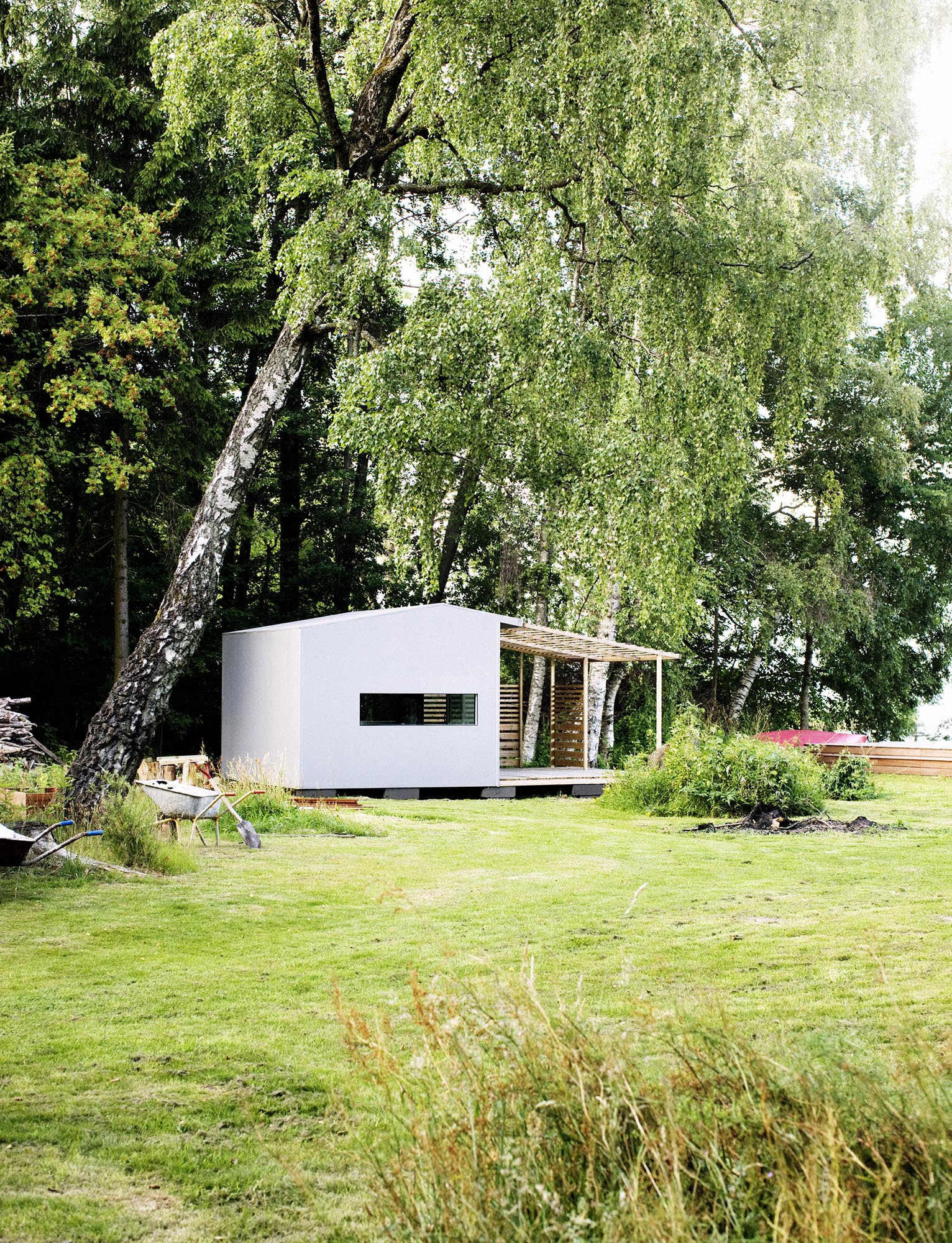

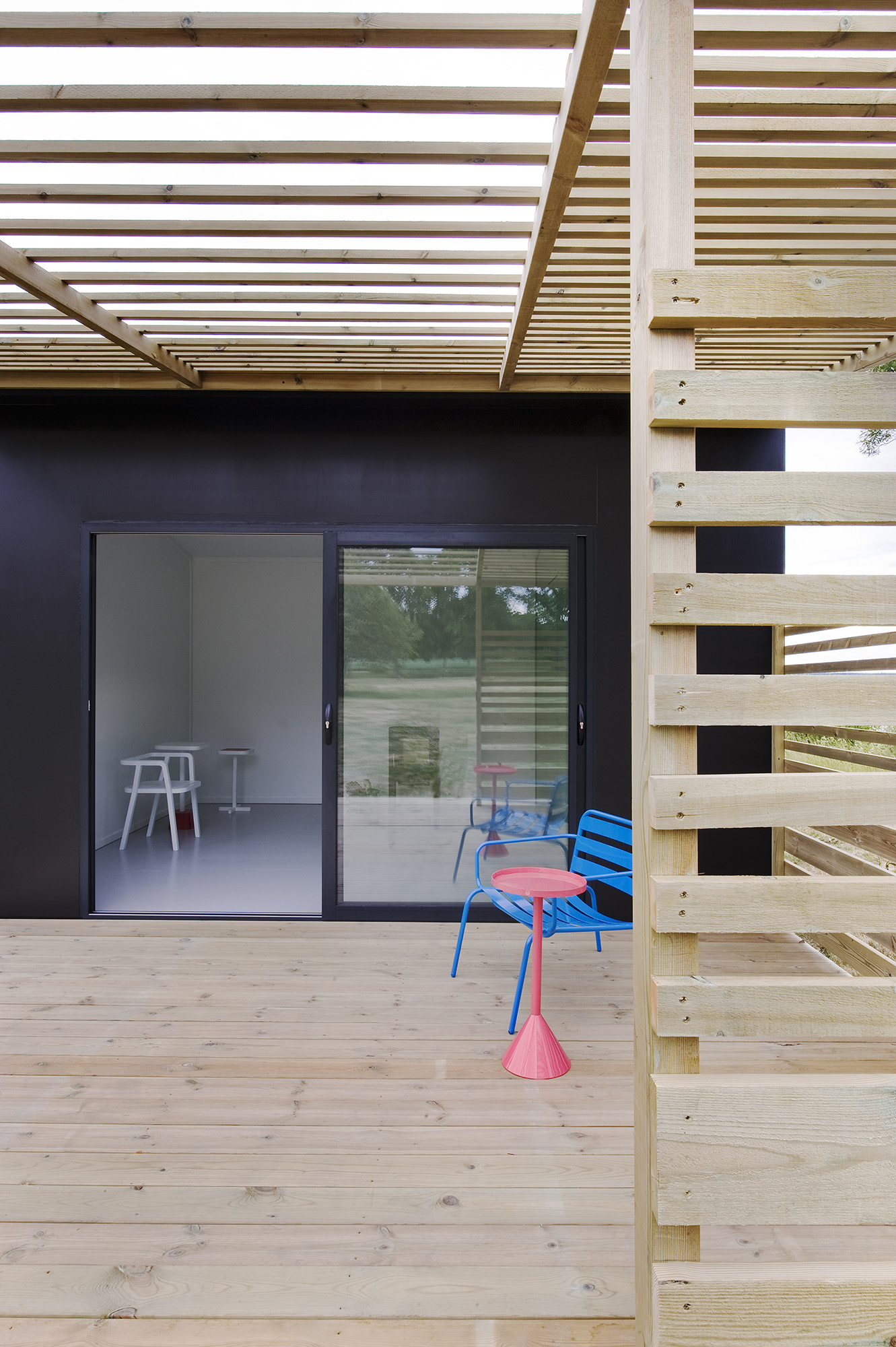
The idea for the Mini House concept started already in year 2006 as a prospect for a Master Thesis at Konstfack University Colleage of Arts, Crafts and Design in Stockholm, Sweden. The creator Jonas Wagell was studying design and architecture and wanted to combine the two in a defined product, which also had a spatial context. The same year the Swedish building code was going through a revision which opened up the opportunity to build a small house without a building permit. This was the starting point of the Mini House concept.

Building permit-free houses
Since Mini House started in year 2006 the context of a school thesis it was required to address innovation, development and reseach. As such the project focused on three areas of developement; building code optimization, creating a defined Product and optimizing production. The first criteria was to challenge the Swedish building code by pushing the limits to what was allowed within Sweden’s building permit free regulations. At the time, a proposition suggested to allow house owners to build a 15 sqm “extra” house without permit and paperwork. The Mini House concept was based on this, but also took advantage of regulations for fences and non-compact structures to create the outdoor pergola which enhances the experienced volume and space.
Architecture as Product design
Furthermore, as a second priority the concept for Mini House addressed marketing and communication values, by suggesting a better defined product, since this was missing on the market. Actually, this was the result, but the starting point was merely a question of why there was such different consumer demands on small houses compared to, lets say cars or bicycles. When the sales proposition for such well-defined products includes optional add-ons and customizations according to the users preferences and needs – why was this not available for small houses?”
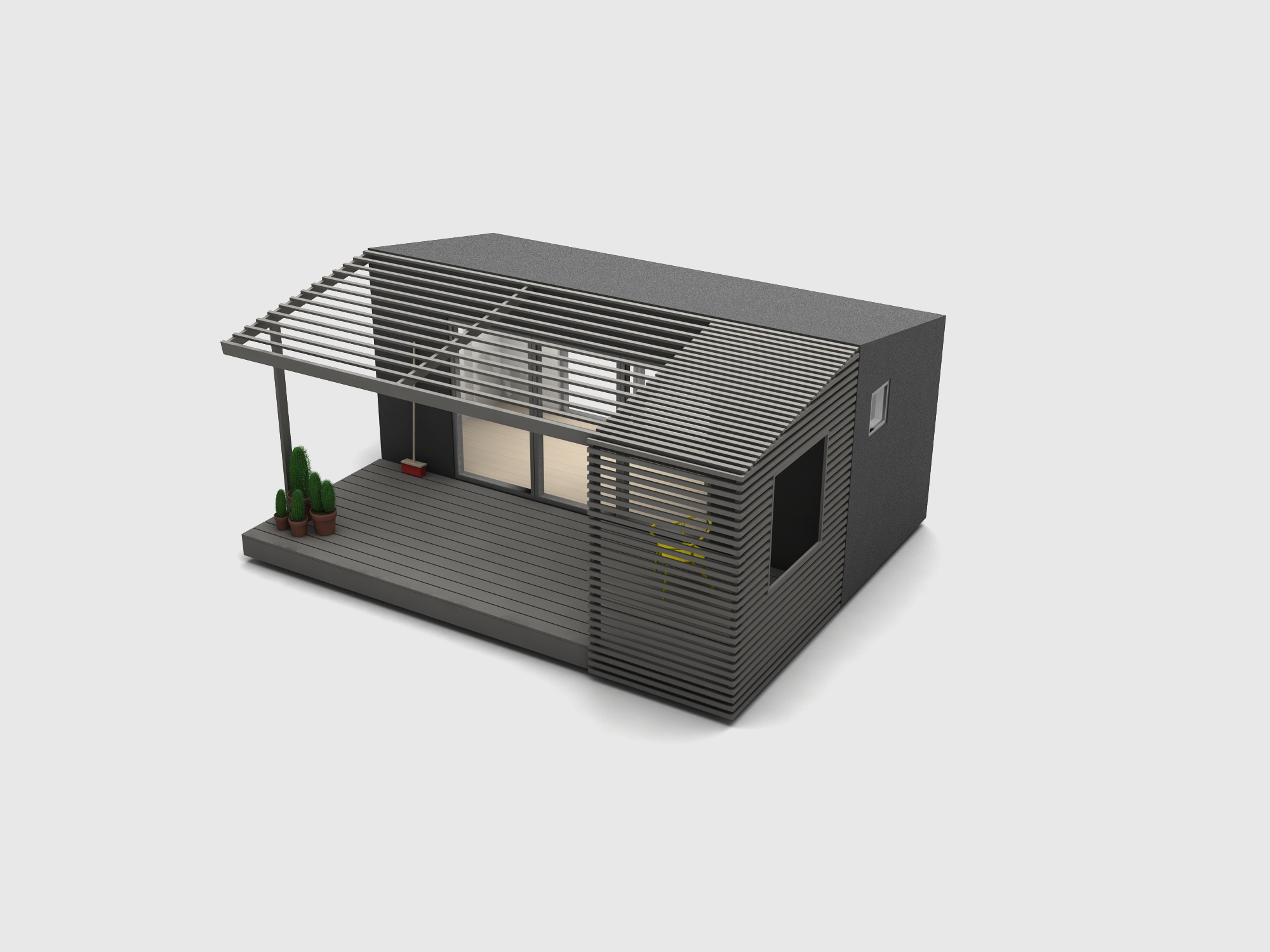
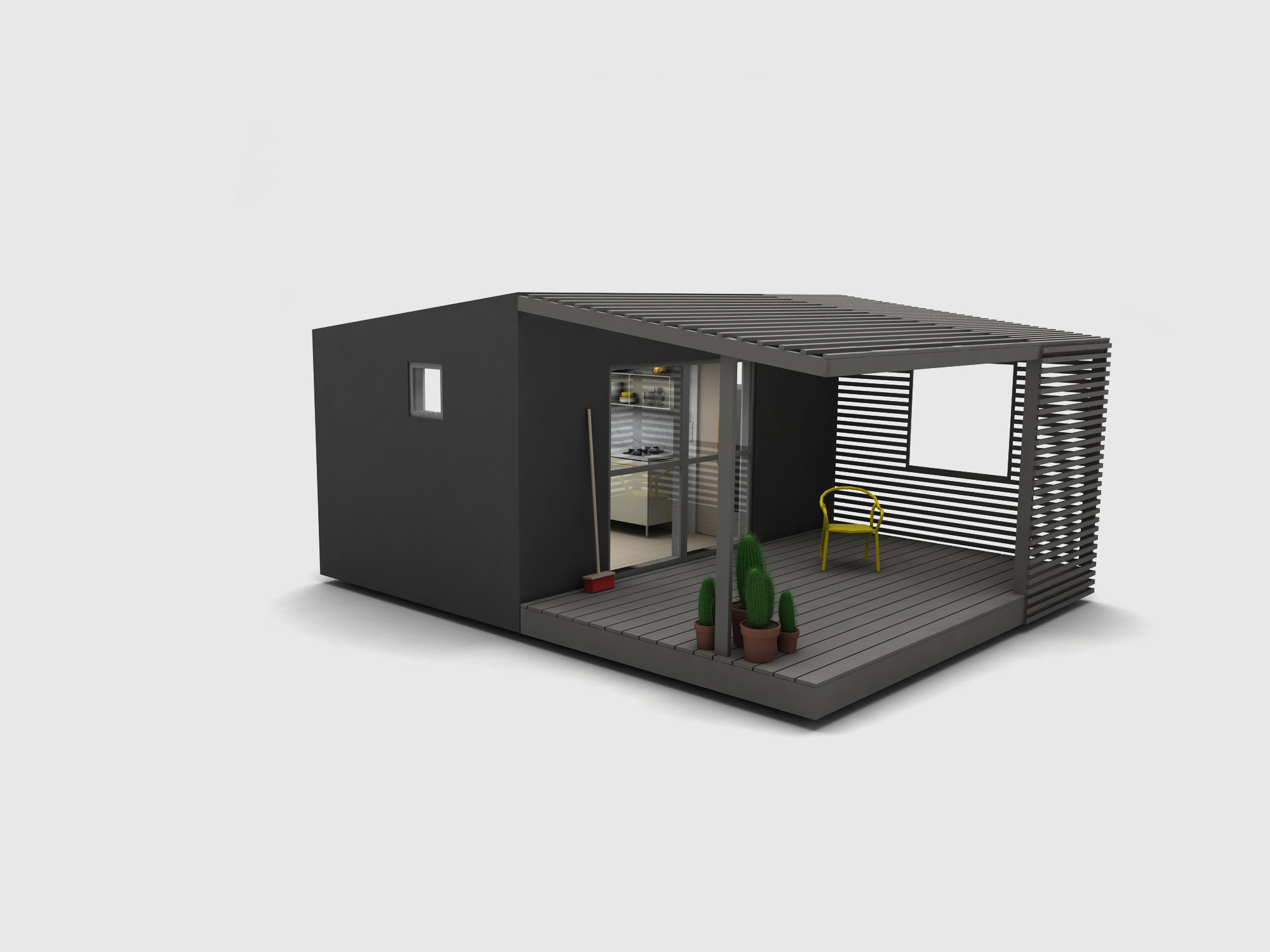
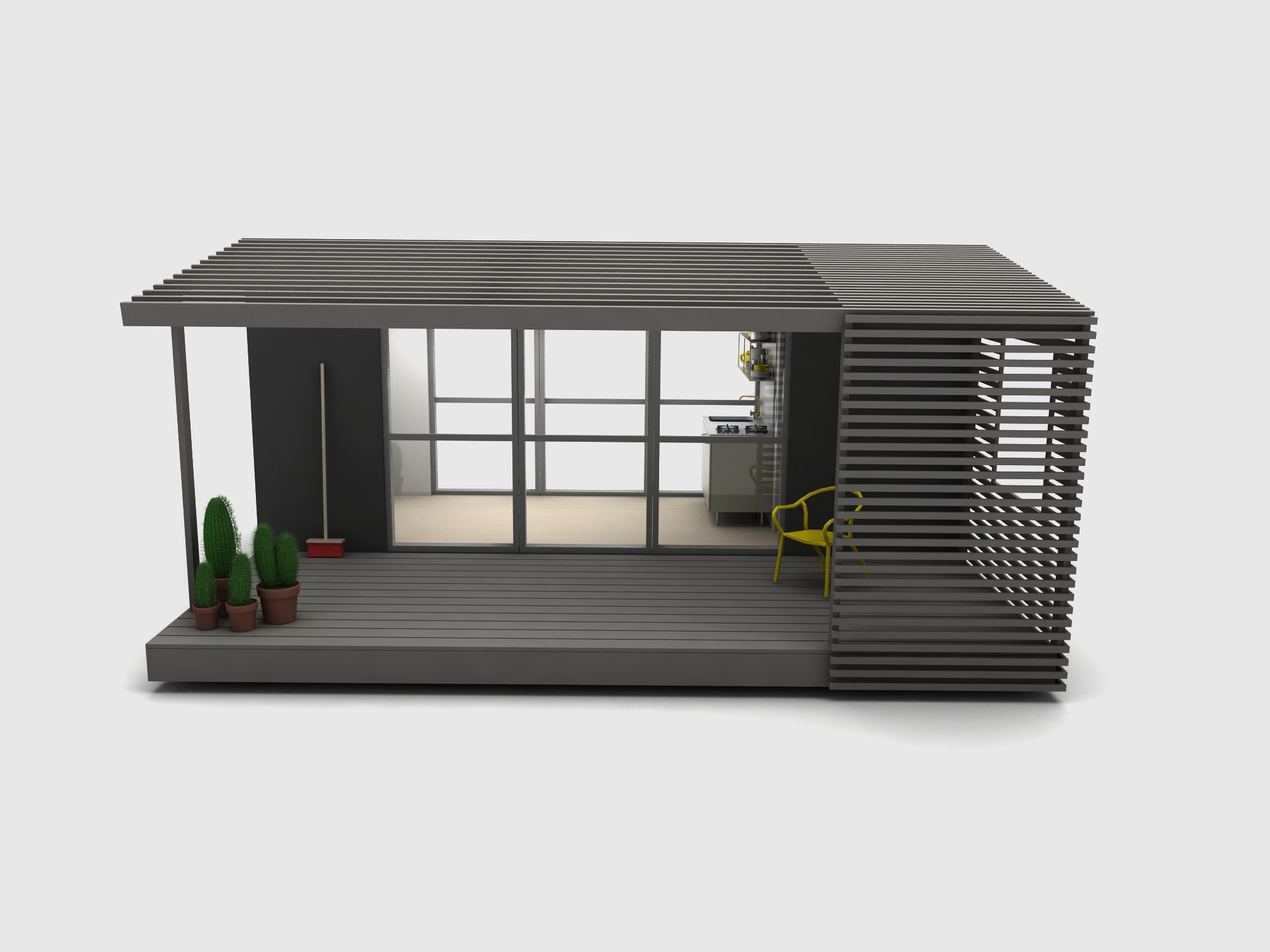
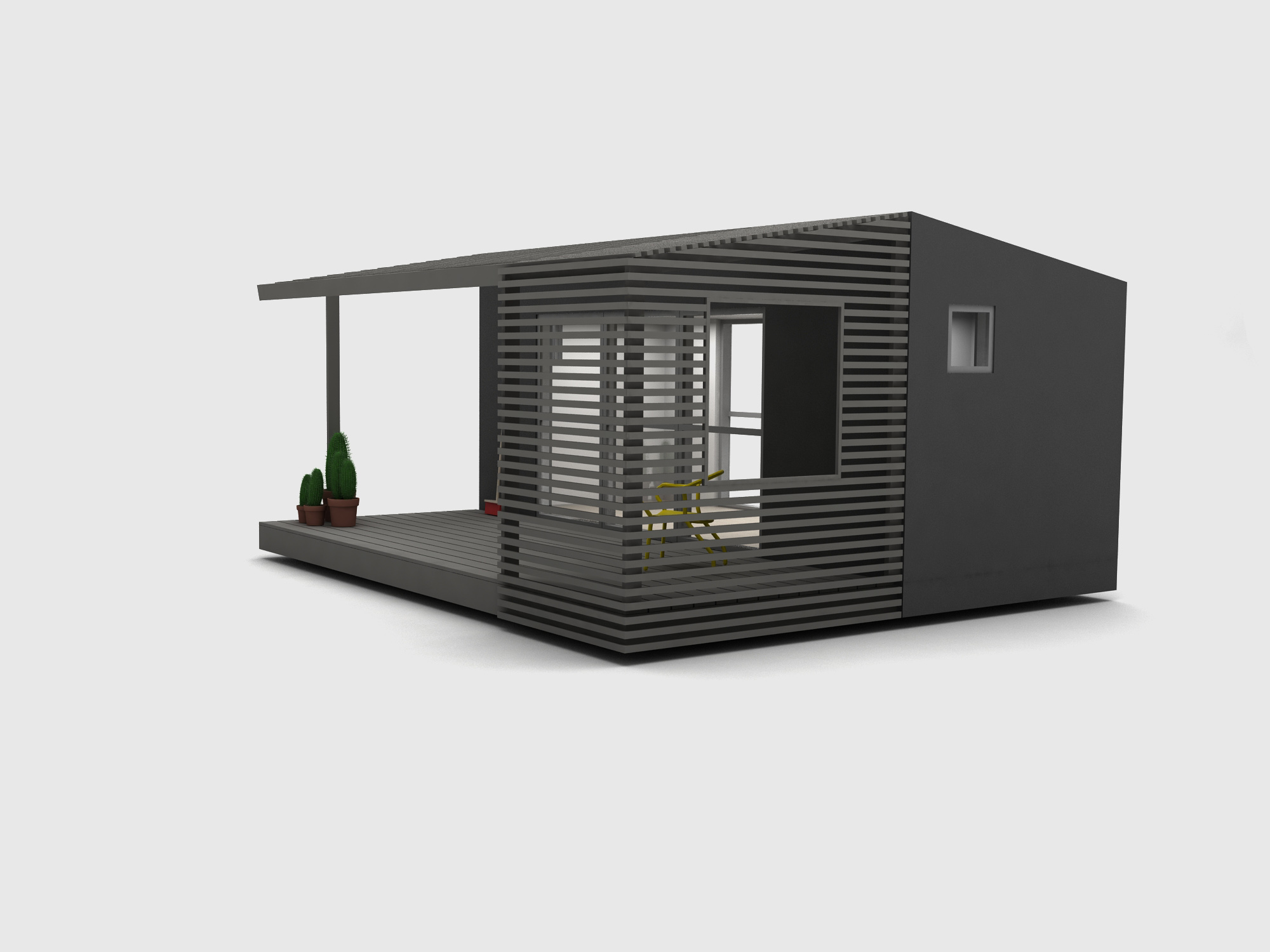
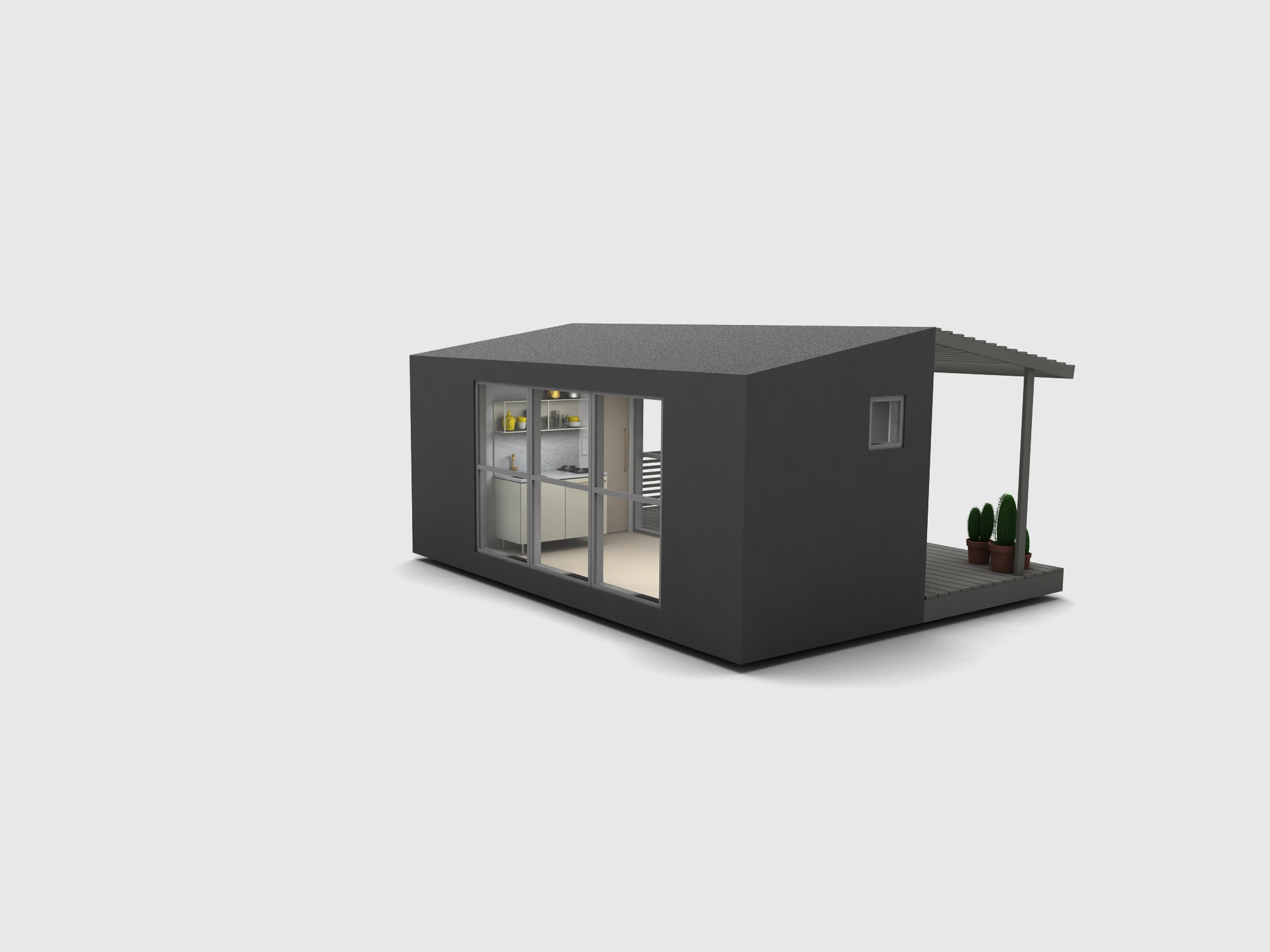
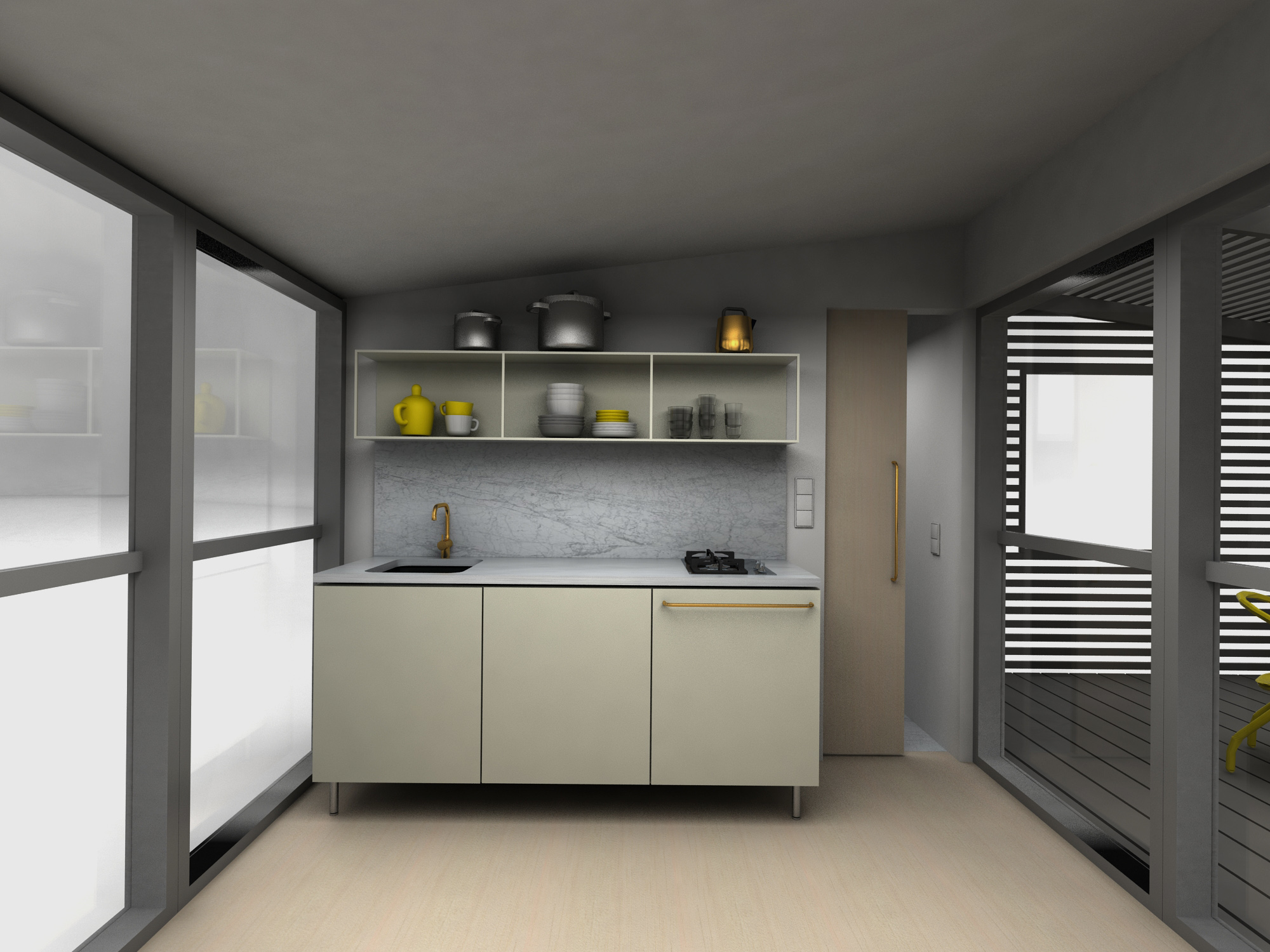
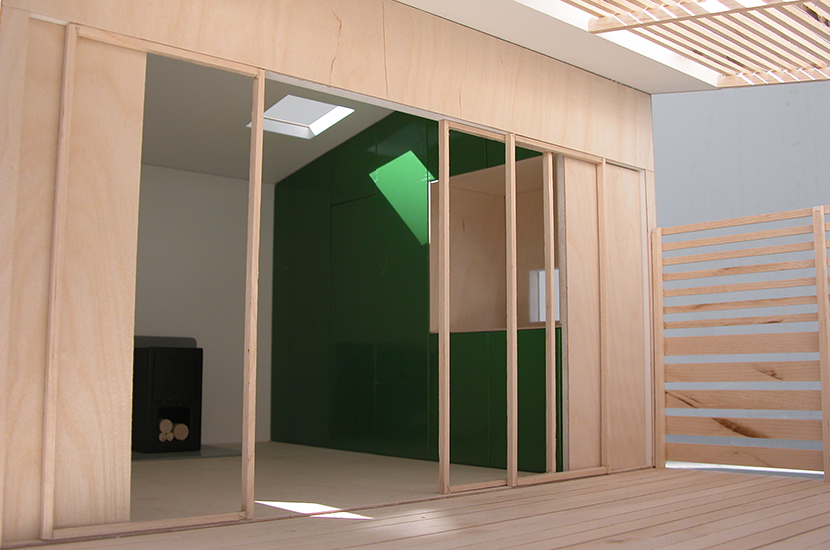

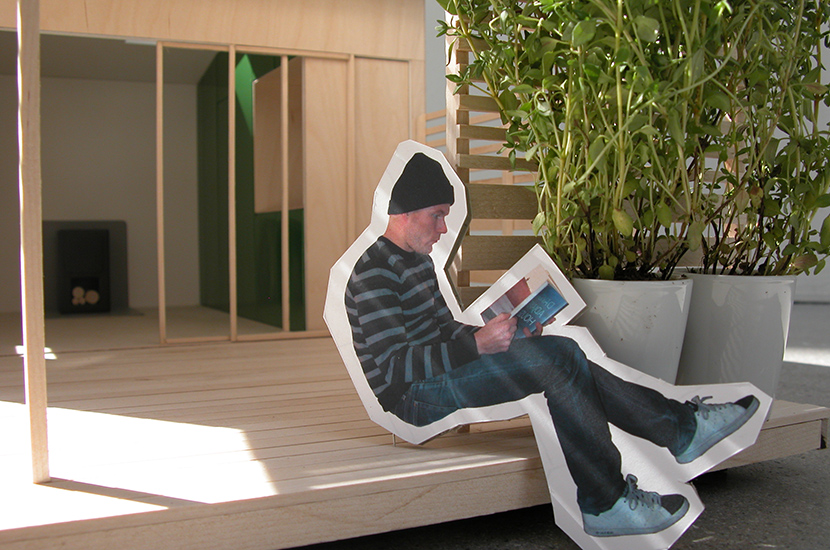
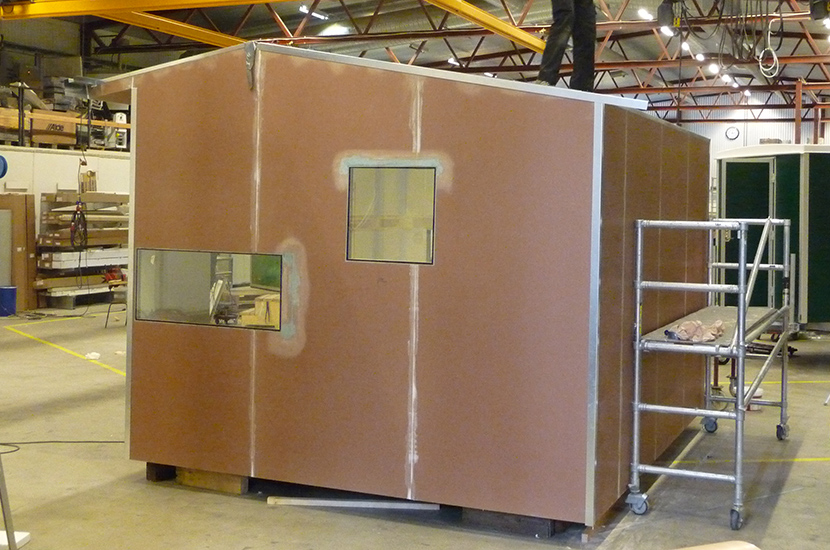
Prefabrication
In Sweden and Scandinavia building permit-free cabins have a long tradition. Perhaps tradition was also the reason they had not changed much in either construction, building materials or design. The last point of interest was therefore to find a way to improve and rationalize manufacture of these small dwellings. The academic context of the project called for a new and innovative approach. In searched of an existing and reliable method, the sandwich construction caught the attention. Sandwich elements of plywood and extruded polystyrene was glued together to form sturdy and insulated, but lightweight blocks which were used to create floor, walls and roof. The first Mini House in 2008 was made as a flatpack construction to be delivered on a truck and assembles on-site.
Creating houses based on sandwich elements is not a new concept, but actually quite common for larger projects. However, for this small scale it was less recognized. This also meant that manufacturing facilities were not many and costs were accordingly. Furthermore, the finished sandwich blocks proved to be less flexible and lightweight in practice, and thus the on-site work was more demanding than expected. As a result, the current Mini House 2.0 is prefabricated as a completely finished and assembled structure with all interior fixture and fittings in place. The prefabricated houses are delivered as whole units on a truck and finally lifted in place with a mobile crane.
An interview with architect and designer Jonas Wagell.
Questions by Sarah Deng, Interior Design China, March 2009.
Please tell us why you wanted to design such a small project as Mini House and why you are interested in small space design?
Well, the project started as my master thesis in fall 2006 at Konstfack University College of Arts, Crafts and Design in Stockholm. Since the beginning of the 1980’s Swedish property owners are allowed to build an extra 10 sqm building on their land without a building permit. This cottage/shed can be placed almost anywhere on the plot which makes it possible to build by the waterfront for example, which normally is restricted in Sweden. These so-called “Friggebod” sheds are very common by still very traditional in construction and look and feel, most oftenly they look like shrinked copies of large timber houses!
During 2006 the allowed size was proposed to be extended to 15 sqm, which is a great difference in volume and space. This was the starting point of the project; to create a 15 sqm house with a simple and contemporary look that also was quick and simple to build! To furthermore create an added value, I studied the building code and found a sort of loophole that makes it possible to build an additional structure – an outdoor room, with walls and roof – the same size as the house itself without permits. As long as the structure is not solid, but allows airflow of at least fifty percent, it is considered a fence by the regulations and then permit-free as well.
Furthermore, I wanted to approach architecture as product design. The same way you find it obvious to be able to select option for your car, you should be able to accessorize a small house. The concept has add-on like a sauna module, a cook-bath module, a storage unit, a heater kit, a solar power unit and more.
Where did you derive your inspiration?
I have always been interested in small spaces – or at least spaces which need customization. I believe it is more interesting and intriguing to develop efficient spaces which need clever and unusual solutions.
What do you think is the most significant concept of the Mini House project?
Since the project was originally made for the Scandinavian market with the building permit-free regulations (15 sqm), the most significant aspect is the optimization of the house in terms of interior space and the addition of the outdoor pergola which doubles the footprint of the house (30 sqm) without any permit needed.
It’s interesting to see that architecture can be custom made. Do you have any foreign clients?
With Mini House I try to look at architecture as product design. We are used to demand more from products such as cars, bicycles etc.in terms of options and add-ons. This approach to architecture is not so common and has attracted interest and created a lot of attention in many countries outside of Scandinavia.
Compared your former similar projects, what is the development in this project?
I believe good design and architecture doesn’t necessarily have to invent something new all the time. The use of new, hi-tech materials is only justified if it creates an added value. Many times designers tend to use materials because they are new and trendy rather than functional for the purpose. Mini house is a project where I have combined well-known and trusted materials and techniques in a new context.
How do you consider the relationship between the house and its surrounding? Even the society?
This is an important question. When I started designing Mini House I pictured it located on the countryside, rather than in urban areas. Specifically, I would have wanted it to be on an island outside of Stockholm.
I want the house to somewhat blend-in and interact with its surrounding. Therefore I have used natural materials such as plywood and solid pine and colours which correspond with rocks, ground and vegetation. Another important aesthetical detail is the pitched roof that connects the house with the pergola but also gives an overall humble and friendly expression, compared to a flat roof.
Furthermore, creating a sustainable house was obvious. The Mini House is prefabricated in all details and the flatpack consists of only seven parts. The walls are made of plywood and expanded polystyrene (EPS) glued together under pressure. EPS consists of 2% polystyrene and 98% air securing a high insulation value and is non-toxic, easy to handle and does not release any harmful gases into the atmosphere. Therefore, the effectiveness of the thermal insulation remains high. Insulation saves energy for heating or cooling of our buildings.
In a political context I believe projects which emphasis thriftiness, economize thinking and sustainability has a role to play, not least in the economies of the world which consume a lot of our common resources.
What kind of lifestyle do you think living in small space can stand for?
I don’t think size necessarily has to do with lifestyle, standard or status. First of all it has to do with preferences and geographical location. Secondly, I would rather measure quality than quantity. My personal opinion is that small space with excellent planning offers an added value.
What do you think is the most important point in small space design?
Storage is the most important. Small spaces easily appear clogged and messy. Good storage facilities and built-in functions create a better spatial quality.
What’s your own opinion on the development of small space design?
I believe it has a purpose as an example of an alternative lifestyle in contrast to consumerism and a non-sustainable lifestyle.
Jonas Wagell Design & Architecture / JWDA
Swedish architect and designer Jonas Wagell is widely revered for his modern product and furniture design comprising soft, minimalist shapes with a welcoming expression. The Stockholm-based studio’s award-winning work combines graphic simplicity and playfulness to create pieces that typify modern-day life.
Words by Rachel Morgan for Audo Copenhagen
→ Read more about the studio!